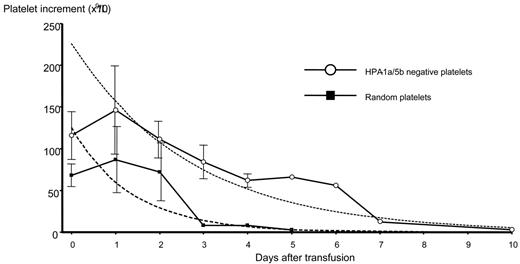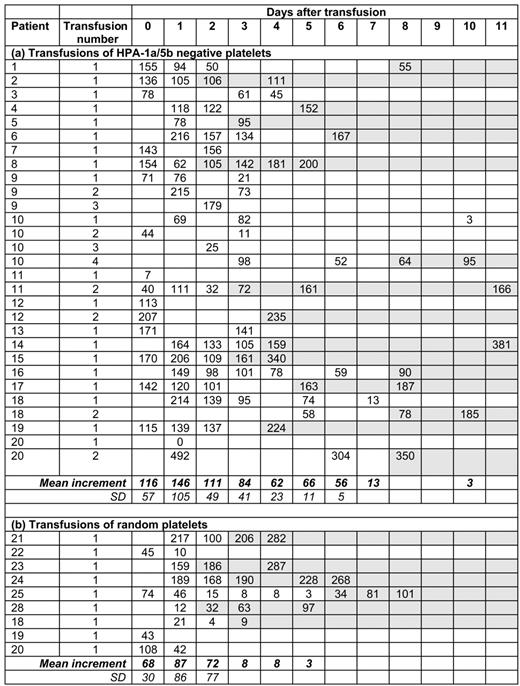To the editor:
We read with interest the article “Antigen-positive platelet transfusion in neonatal alloimmune thrombocytopenia (NAIT)” by Kiefel et al.1 The authors describe the outcome of 27 neonates with anti–HPA-1a–mediated NAIT treated with random donor platelet transfusions. They found that 24 of these neonates achieved platelet counts higher than 40 × 109/L and concluded that random donor platelet transfusion is an acceptable strategy for the management of severe index cases of NAIT before compatible platelets are available.
While we agree with this conclusion, we wish to stress that antigen-negative platelets are the treatment of choice for NAIT. The National Blood Service in England provides HPA-1a/5b–negative platelets for immediate treatment of neonates with a presumptive diagnosis of NAIT. We have compared the platelet counts and clinical outcome in neonates with anti–HPA-1a– and anti–HPA-5b–mediated NAIT transfused with HPA-1a/5b–negative platelets (ie, antigen-compatible transfusion [AC-Tx]) versus random donor platelet transfusion (R-Tx). In many cases of NAIT, a spontaneous recovery in platelet count is seen, and some are apparent in the study of Kiefel et al (eg, cases 1, 4, and 9). In such cases, it is difficult to be sure of the contribution of the transfused platelets to the increase in platelet count; we have therefore excluded such cases from our calculations (Figure 1; Table 1).
Mean platelet increments in neonates with NAIT following HPA-1a/5b–negative platelet transfusions or random donor platelet transfusions. The mean platelet increments in neonates with anti–HPA-1a– and/or anti–HPA-5b–mediated NAIT following HPA-1a/5b–negative platelet transfusions (n = 29) (open circles) or random donor platelet transfusions (n = 9) (closed squares) are shown. The error bars represent the standard deviation of the measurements. The dotted curves represent the fitted exponential decay curves to the data. The individual patient data are given in Figure 2.
Mean platelet increments in neonates with NAIT following HPA-1a/5b–negative platelet transfusions or random donor platelet transfusions. The mean platelet increments in neonates with anti–HPA-1a– and/or anti–HPA-5b–mediated NAIT following HPA-1a/5b–negative platelet transfusions (n = 29) (open circles) or random donor platelet transfusions (n = 9) (closed squares) are shown. The error bars represent the standard deviation of the measurements. The dotted curves represent the fitted exponential decay curves to the data. The individual patient data are given in Figure 2.
Platelet increments in response to individual platelet transfusions. The platelet increments (×109/L; ie, platelet counts after transfusion minus the pretransfusion count) are given for each transfusion. In the absence of further transfusions, increments that are rising are presumed to have a contribution from fetal platelet regeneration and are not included in the calculations of mean increments; these cells are shaded gray.
Platelet increments in response to individual platelet transfusions. The platelet increments (×109/L; ie, platelet counts after transfusion minus the pretransfusion count) are given for each transfusion. In the absence of further transfusions, increments that are rising are presumed to have a contribution from fetal platelet regeneration and are not included in the calculations of mean increments; these cells are shaded gray.
The transfusion of random platelets did result in a rise in platelet count (mean increments: 68 × 109/L and 87 × 109/L at day 0 and day 1, respectively), but this was significantly and consistently less over the lifespan of the transfused platelets than the mean increment seen with AC-Tx (116 × 109/L and 146 × 109/L on days 0 and 1, respectively). More importantly, the survival of the random platelets was only approximately half that of antigen-compatible platelets (T1/2 of random platelets, 1.0 days; antigen-compatible platelets, 1.9 days) (Figure 1).
The range of day-1 increments varied widely, both with R-Tx (range: 10-217 × 109/L) and AC-Tx (range: 62-216 × 109/L). Unexpectedly large increments may occur with R-Tx when a proportion of the platelets is coincidentally HPA-1a/5b negative (estimated likelihood, 1 in 13 where the platelet pool is from 4 “random” donors)2 ; unexpectedly low increments may be seen with AC-Tx due to the presence in the fetal circulation of maternal HLA class I antibodies3 or when platelet transfusions are inappropriately administered. Babies with NAIT should therefore have their platelet counts monitored regularly whatever treatment is used and appropriate changes to treatment instigated when necessary.
In conclusion, we agree with Kiefel et al that R-Tx is an acceptable initial treatment for NAIT where HPA-1a/5b–negative platelets are not immediately available. However, our data show that HPA-1a/5b–negative platelets give larger increments, have a longer half-life, and only occasionally fail to provide therapeutically significant platelet increments. We therefore encourage blood services in other countries to establish panels of HPA-1a/5b–negative donors to provide HPA-1a/5b–negative platelets for immediate use in cases of suspected NAIT and for intrauterine or neonatal therapy of cases of known NAIT.4
Conflict-of-interest disclosure: The authors declare no competing financial interests.



